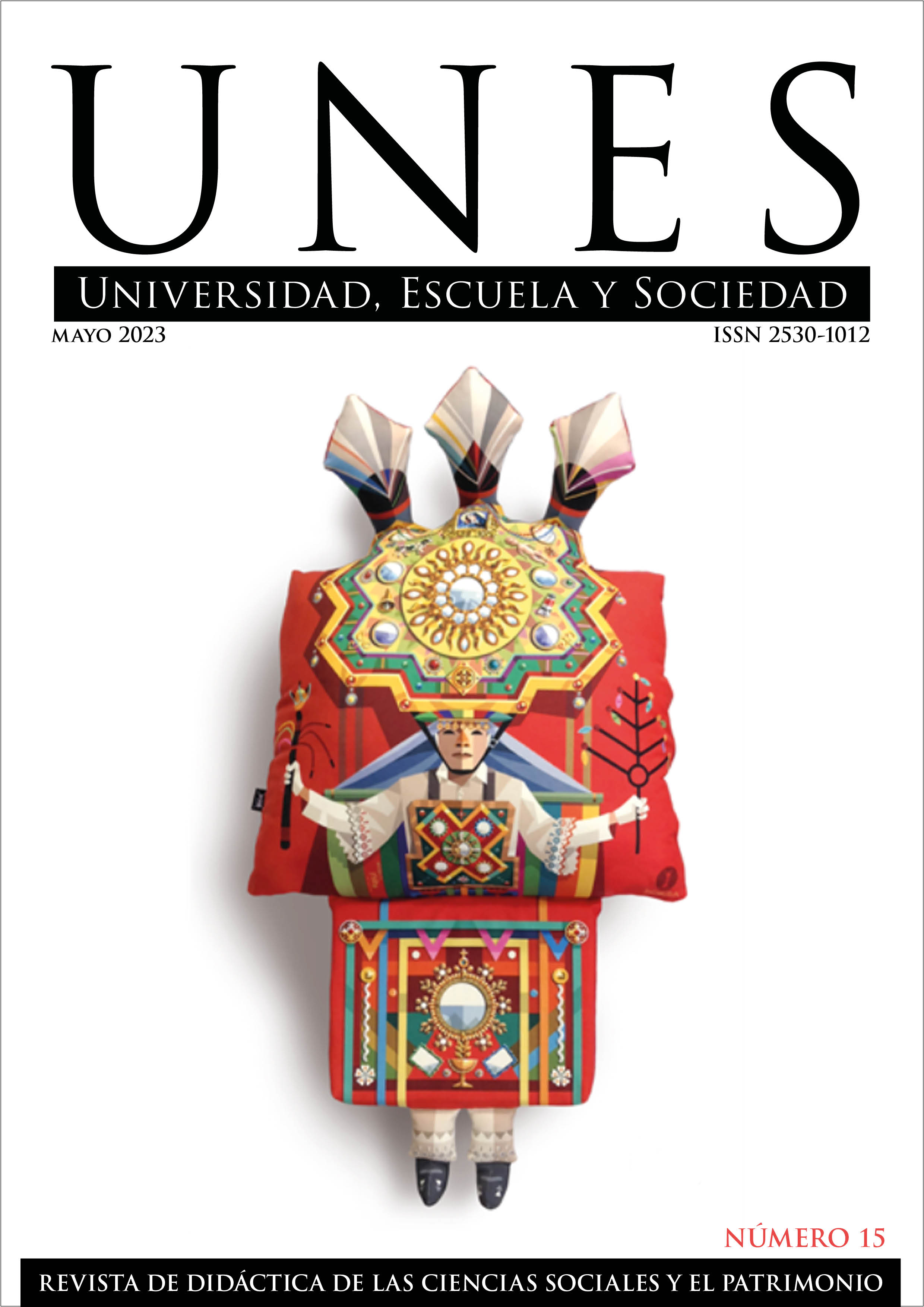Training in the specialist person for community cultural mediation
DOI:
https://doi.org/10.30827/unes.i15.27489Keywords:
mediación, cultural, patrimonioAbstract
Introduction: the research corresponds to a contextual delimitation, on contents that are developed within the framework of a patrimonial education that is present, implicitly, in community environments, where dynamics of safeguarding their legacies are generated from the valorization of their own.
The set of social actions that allow community processes to be dynamized include elements of intangible cultural heritage (such as the case of oralities) and require a technical guideline that strengthens the interaction between the local inhabitants of a community with their legacies; that is to say, that the mediation that occurs spontaneously must consider a pedagogy from the non-formal, in order to generate an optimal attitude and behavior for the training of cultural mediators.
Method: an analysis is carried out on mediating dynamics in several community-based territories, in which mediation has been identified, not only present as a linking instrument between heritage spaces and the population itself, but also in determining the way in which that people recognize a character of interculturality by being in constant social coexistence with audiences and/or visitors from outside the community.
Results: the training that is determined, to achieve effective cultural mediation, is presented through the proposal of a training model built to be applied in community heritage environments.
Conclusions: a cultural mediation, in relation to the space in which it is carried out, forces the mediator to be the architect of the management of the patrimonial educational dynamic, and for this he needs specific training.
Downloads
References
Álvarez-Rodríguez, D., Marfil-Carmona, R., & Báez-García, C. (2019). Investigación de impacto sobre la formación en mediación y educación en museos: análisis de la Web of Science. Revista electrónica interuniversitaria de formación del profesorado, 22(1), 121-144. http://dx.doi.org/10.6018/reifop.22.1.357731
Arriaga, A. (2019). De la educación a la mediación. Tensiones en torno a la situación de las educadoras y al trabajo con los públicos en museos y centros de arte. Her&Mus. Heritage & Museography, 20, 189-206.
Cano, R. (2018). Pueblos indígenas y museos etnográficos. https://www.researchgate.net/publication/326649412_PUEBLOS_INDIGENAS_Y_MUSEOS_ETNOGRAFICOS
De Carli, G. (2018). El Patrimonio. Su definición, gestión y uso social. ILAM. https://ilamdocs.org/documento/3505/
Dormaels, M. (2011). Patrimonio, patrimonialización e identidad. Hacia una hermenéutica del Patrimonio. Herencia, 7-14. https://revistas.ucr.ac.cr/index.php/herencia/article/view/1432
Henao, S. (2022). Educar para musear y musear para educar. El rol educativo del Museo La Tertulia. Un análisis de su área de Educación y Cultura. [Tesis de Licenciatura, Universidad del Valle] Repositorio institucional de la Universidad del Valle https://bibliotecadigital.univalle.edu.co/bitstream/handle/10893/22196/3251%20H493ed.pdf?sequence=1&isAllowed=y
Jofré, I. (2017). Una mirada crítica de los procesos de patrimonialización en el contexto megaminero. En J. Pellini, Arqueología Comercial en América del Sur (págs. 143-175). Madrid: JAS Arqueología. https://www.academia.edu/40321157/UNA_MIRADA_CR%C3%8DTICA_DE_LOS_PROCESOS_DE_PATRIMONIALIZACION_EN_EL_CONTEXTO_MEGA_MINERO_Tres_casos_emblem%C3%A1ticos_en_la_provincia_de_Provincia_de_San_Juan_Rep_Argentina?auto=download
Llull, J. (2005). Evolución del concepto y de la significación social del patrimonio cultural. Arte, individuo y sociedad, 17, 177-206. https://revistas.ucm.es/index.php/ARIS/article/view/ARIS0505110177A
Mariño, G. & Cendales, L. (2004). Educación no formal y educación popular. Caracas: Federación Internacional de Fe y Alegría. https://www.feyalegria.org/wp-content/uploads/fya-biblioteca/images/acrobat/EducNoFormalEducPopular_4834.pdf
Molina, L. H. (2013). El cambio de paradigma del proceso artístico en el mundo contemporáneo. En D. J. Sánchez, Epistemología de las artes. La transformación del proceso artístico en el mundo contemporáneo (págs. 13-27). Argentina: Ed. de la Universidad Nacional de La Plata. Libros de Cátedra. http://sedici.unlp.edu.ar/handle/10915/131560
Ortiz, A. (2013). Modelos pedagógicos y teorías del aprendizaje. Bogotá: Ediciones de la U. https://www.researchgate.net/publication/315835198
UNESCO. (2014). Gestión del Patrimonio Mundial Cultural. París: UNESCO. https://whc.unesco.org/document/130490
UNESCO. (2015). Recomendación relativa a la protección y promoción de los museos y colecciones, su diversidad y su función en la sociedad. https://unesdoc.unesco.org/ark:/48223/pf0000245176.page=14
Zavala, L. (2014). Antimanual del museólogo. México: INAH. https://evemuseografia.com/wp-content/uploads/2022/02/Antimanual-del-museologo.pdf
Zepeda, N. (2014). Mediación en el Museo [Parte 1]. Objetivos y funciones del mediador. https://nodocultura.com/2014/01/30/mediacion-en-el-museo-parte-1/
Downloads
Published
How to Cite
Issue
Section
License
Copyright (c) 2023 Santiago Buitrón Chávez, María Isabel Moreno Montoro

This work is licensed under a Creative Commons Attribution-NonCommercial-ShareAlike 4.0 International License.
Authors being published in this journal agree to the following terms:
The authors retain their copyrights but guarantee the journal's right to be the first publisher of the work, licensed under a Creative Commons Attribution-NonCommercial-ShareAlike 4.0 International license, which allows others to share the work, provided that they acknowledge its authorship and initial publication in this journal.
Authors may separately subscribe additional agreements for the non-exclusive distribution of the work published in the journal (for example, including it in an institutional repository or publishing it in a book), with recognition of its initial publication in this journal.
Authors are allowed and encouraged to disseminate their work electronically (for example, in institutional repositories or on their own websites) before and during the submission process, as this may result in productive exchanges, as well as more and earlier citations of the works to be published (See The Effect of Open Access) (in English).






 ISSN-e: 2530-1012
ISSN-e: 2530-1012









